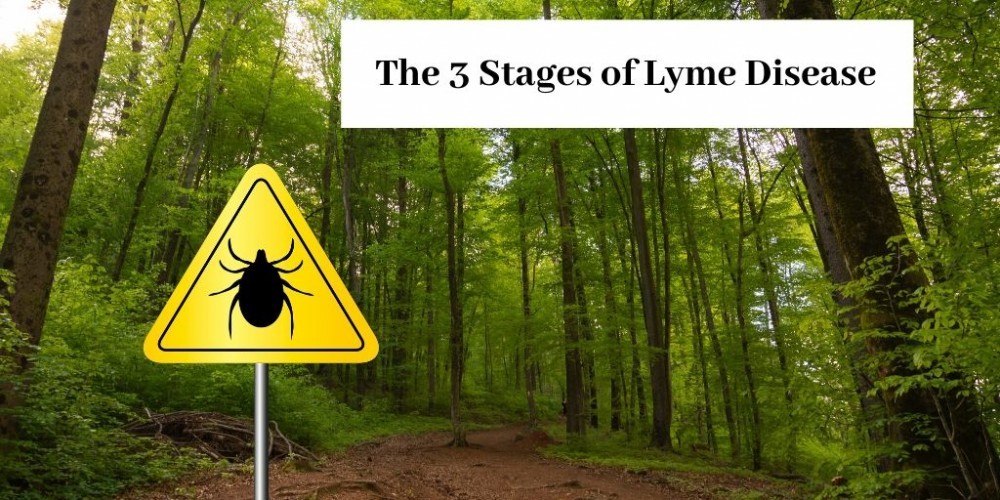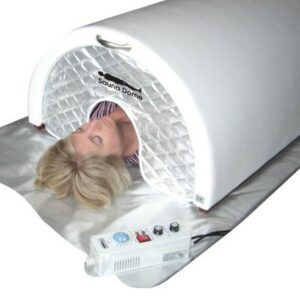Lyme disease progresses in 3 stages, with symptoms ranging from mild to debilitating, if left untreated. Knowing the symptoms and getting an early diagnosis is critical. What are the 3 stages of Lyme disease?

Table of Contents
What Is Lyme Disease?
Lyme disease is the most common vector-borne disease, and is caused by the borrellia burgdorfei bacterium, or spirochete. Spirochetes are shaped like a corkscrew, enabling them to burrow into tissues where they can remain undetected by the immune system. The disease was first identified in 1975 in Lyme, Connecticut, hence its name. Two years later, the deer tick who becomes infected while feeding on mice or deer, was implicated in the transmission of the disease. Tick bites become infectious if a tick is not removed within 12-24 hours, allowing them to feed.

It’s possible that ticks aren’t the only insects that transmit the disease. It may be that mosquitos, mites, fleas, and even flies are carriers, as well. Sadly, evidence shows that the infection can be transmitted during sex, pregnancy, and possibly breastfeeding. Lyme is often called the great imitator because it can mimic other diseases, with symptoms appearing, disappearing, and reappearing. It is notoriously difficult to treat.
Spirochetes behave similarly to viruses, in that they can be intracellular, and can take on different morphologies, including the cystic form that can persist similarly to the bacteria that causes syphilis. Cystic forms of the disease can be treatment-resistant. One reason Lyme is so hard to treat is that spirochetes encase themselves in biofilms, mucus-type encasements, that prevent antibiotics from reaching them.
The 3 Stages Of Lyme Disease
1.  Localized Lyme Disease | Stage 1
Localized Lyme Disease | Stage 1
Also, referred to as localized Lyme disease, this stage can last from one to four weeks, with symptoms manifesting anywhere from 3 to 30 days after getting bit by an infected tick. The hallmark sign of this stage is a bull’s-eye rash, which is an allergic reaction to the tick’s saliva. Rashes can gradually expand up to 12 inches in diameter, and may be warm to the touch, but typically aren’t painful.
However, many people don’t get a rash after being infected. The ones who do get a rash are fortunate because it confirms the presence of the disease. The earlier the disease can be identified and treated, the better. Some people are asymptomatic in this stage. For those who are symptomatic, symptoms include:
- Swollen lymph nodes
- Fever and chills
- Sore throat
- Joint paint
- Fatigue
- Headaches
- Stiffness and swelling
- Bull’s-eye rash
2. Early Disseminated Lyme Disease | Stage 2
Second-stage Lyme, or disseminated Lyme disease, begins weeks or months following infection, with symptoms of stage 1 and stage 2 potentially overlapping. In stage 2, the bacteria spreads and multiplies throughout the body, resulting in worsening symptoms. Borrelia burgdorferi is unique in that it can penetrate the blood-brain barrier, infecting the central nervous system and causing inflammation.
This can lead to the extreme fatigue that a high percentage of people with Lyme experience. Neurocognitive problems, like memory loss, an inability to concentrate, and lack of coordination can begin to manifest in this stage. Brain inflammation can cause intense migraine-type headaches that are accompanied by extreme sensitivity to light or noise. If the disease remains untreated, the worsening infection can lead to behavioral changes. Other symptoms include:
- Enlarged lymph nodes
- Fatigue
- Muscle aches and flu-type symptoms
- Fever, chills, and sore throat
- Neurological symptoms
- Rashes
- Sensitivity to light and noise
- Pain, tingling, and numbness
- Headaches
- Changes in vision
- Heart arrhythmias and palpitations
- Meningitis
3. Late Disseminated or Persistent Chronic Lyme Disease | Stage 3
Late-stage Lyme disease can occur months, or sometimes years after infection, if not treated. Symptoms can be life-threatening and severe. As the bacterium spreads it affects the heart, brain, nervous system, and muscular-skeletal system, including substantial joint damage. In fact, Lyme was originally called Lyme arthritis, due to its effects on joints.
Arthritic-type symptoms wax and wane, negatively impacting knees, hips, and other joints. As the inflammatory process progresses unabated, tissue is damaged and cartilage and bone attacked. Spirochetes can invade heart tissue, causing inflammation, tachycardia, heart palpitations, dizziness, shortness of breath, and fainting. Stress of any kind, including exercise, can exacerbate symptoms.
Flu-like symptoms are the result of the immune system trying to fight the infection. These symptoms differ from garden variety flu symptoms in that congestion and coughing aren’t part of the picture. The longer the disease progress without intervention, the harder it becomes to treat. As the infection becomes chronic, antibody production is suppressed due to stress on the immune system, making it more difficult to diagnose. Other symptoms include:
- Arthritis
- Brain disorders
- Neck stiffness
- Fluid buildup
- Headaches
- Numbness
- Temporary amnesia
- Heart problems
- Nervous system disorders
- Exhaustion
- Liver disease
- Paralysis of facial muscles
- Memory and concentration problems

Conventional Treatments
Receiving a Lyme diagnosis is not a simple matter, which is unfortunate, because if diagnosed early and treated, the bacterium can be eradicated. Ticks are small, and people often have no idea they’ve been bitten. Many people chalk their joint pain and muscle aches to other more common conditions. To complicate matters, borrellia runs in a pack with other coinfections like babesia, a malaria-type parasite, and bartonella, a gram-negative bacterium.
Physical exams, health histories, and blood tests are used to diagnosis the disease. Spirochetes can be seen on live blood analysis using dark field microscopy. Blood tests are the most accurate in the early stages of the disease when antibodies can still be detected. False negatives can occur up to 1/3rd of the time. The disease is conventionally treated with antibiotics, namely doxycycline, amoxicillin, and cefuroxime.
Antibiotics that work intracellularly are also used. Sadly, symptoms such as joint pain, may not completely resolve after treatment. Blood tests that are used to diagnose Lyme include the ELISA assay, which detects antibodies against the borrellia bacterium, the Western blot that identifies antibodies against borrellia proteins, and polymerase chain reaction (PCR), which evaluates spinal and joint fluid. The latter is used for people who present with Lyme arthritis and neurological symptoms.
True Health Labs offers a variety of tests you can order online without a doctor’s order:
Lyme ImmunoBlot IgG and IgM + PCR Test
Access all tests here
This post contains affiliate links ✔️
Alternative Lyme Treatments
Lyme can also be treated alternatively, in conjunction with conventional treatments, or alone. A number of healing modalities are used simultaneously, and many of them can be done at home including:
- Herbal antibiotics: Herbal preparations are used alternatively for Lyme because many of them are able to get inside the cell. Samento, olive leaf extract, grapefruit seed extract, systemic enzymes, and colloidial silver are a few examples of non-pharmaceutical antibiotics. The Cowden Support Program has been used with great success, and uses 14 Nutramedix products that are rotated. Homeopathy is also used.
[Read More: High Dose Enzyme Therapy For Cancer]
- Nutritional IV therapies: Vitamins, minerals, and antioxidants are delivered intravenously, bypassing the GI tract, and strengthening the immune system.
[Read More: How To Make Liposomal Vitamin C In Your Own Kitchen]
- Detoxification strategies: Techniques such as juicing, colonics, coffee enemas, liver cleanses, and rebounding are used to detoxify the liver, gallbladder, lymph, and intestines. Detoxification is critical for good immunity.
[Read More: Benefits Of Using A Lymphatic Drainage System From Home]
- Hyperbaric oxygen therapy (HBOT): The borrelia bacterium is considered microaerophilic, which means it requires small amounts of oxygen for survival, but dies in the presence of copious amounts. Hyperbaric modulates immune function, detoxifies, increases energy, and reduces pain.
[Read More: 10 Benefits of Hyperbaric Oxygen Therapy] 
- Rife: All organisms, including bacteria, resonate at specific frequencies. A rife machine is able to eradicate pathogenic organisms by directing beams that are programmed at the same resonancy. Rife is used for general healing, pain reduction, and depression. It’s cost-effective to purchase your own rife machine.
[Read More: How Does Rife Frequency Therapy Target & Destroy Pathogenic Micro-Organisms?]
- Pulsed electromagnetic frequency therapy (PEMF): PEMF stimulates cellular repair by delivering magnetic pulses to tissues, raising the membrane potential, which improves cell metabolism. PEMF therapy has been shown to produce an analgesic effect, is used to reduce inflammation, oxygenate the body, improve circulation and nutrient absorption, and promote lymphatic drainage and detoxification. The most effective way to receive the benefits is to buy your own pulsed magnetic field generator.
[Read More: 4 Ways Pulsed Electromagnetic Field Therapy Destroys Cancer Cells]
- Ozone: Ozone is a powerful biofilm buster, and is anti-inflammatory, anti-viral, and anti-bacterial. It improves immune function and circulation, protects the liver, stabilizes moods, improves cellular metabolism, boosts energy, and eliminates joint pain. Ozone is administered in a variety of ways, including intravenously, and by direct injection to repair joints, ligaments, cartilage, and tendons, making it particularly applicable for Lyme arthritis. You can buy your own generator to use at home.
[Read More: Benefits Of Ozone Sauna Therapy]
- Far Infrared saunas: Detoxification is vital for people suffering from Lyme. Spirochetes release toxins as they die so it’s imperative that detox techniques be used when treating the disease to prevent Herxheimer reactions, a result of toxin build-up. Sweating releases environmental toxins, heavy metals, and other chemicals. Saunas support the immune system, decrease pain, improve circulation, and promote relaxation. Sauna therapy can be enjoyed in the comfort of your own home.
[Read More: Benefits Of Ozone Sauna Therapy]
- Medical marijuana: Cannabis is effective at reducing the symptoms associated with Lyme. It relaxes muscles, reduces inflammation, improves stiffness and joint pain, and aids in restful sleep, which can be elusive for infected people.
[Read More: 10 Ways To Use CBD Oil For Chronic Illness, Inflammation & Pain]
- Acupuncture: Stimulation of acupuncture points activates pathways that strengthen the immune system. Acupuncture can improve the symptoms of Lyme by decreasing inflammation, improving circulation and pain, and promoting relaxation.
Key Points
The saying “An ounce of prevention is worth a pound of cure” is particularly relevant in the case of Lyme disease, which is difficult to diagnose, due to the ability of spirochetes to evade the immune system.
Protect yourself by wearing long sleeves and pants when hiking or walking in grassy areas, perform frequent tick checks on your entire body, as well as on any pets you have, and get any suspicious symptoms checked immediately. Once the acute form of the disease progresses to chronic, it can be hard to treat.
Were you aware that Lyme disease had 3 stages? Let me know in the comments:)
References:
(1) Centers for Disease Control and Prevention: Signs and Symptoms of Untreated Lyme Disease
(2) NCBI US National Library of Medicine National Institutes of Health: Persisting atypical and cystic forms of Borrelia burgdorferi and local inflammation in Lyme neuroborreliosis
(3) Centers for Disease Control and Prevention: Symptoms of Bartonella henselae
(4) lymedisease.org Advocacy, Education & Research: Lyme Disease Co-infection: Babesiosis
(5) TreatLyme by Marty Ross MD: A Lyme Disease Antibiotic Guide
(6) Prevention: 7 Lyme Disease Symptoms That Are Way To Easy Too Ignore
(7) Lyme Warrior: Rife for Lyme Disease
(8) Naturopathic Options: Ozone and IV therapy: Turning the Key for Lyme Disease Recovery
(9) NCBI US National Library of Medicine National Institutes of Health: A randomized, double-blind, placebo-controlled clinical trial using a low-frequency magnetic filed in the treatment of musculoskeletal chronic pain
(10) PEMF Therapy education: How PEMF Therapy Impacts The Active Infection Of Lyme Disease
Disclaimer: This article is strictly for informational purposes only and is not intended to be medical advice.




I could not see what the pictures were in your post, but overall you had some great information about Lyme disease. After reading about everything that could happen to the body, it’s good to know that there is a great emphasis on prevention.
I will definitely be protecting myself by wearing long sleeves and pants when hiking or walking in grassy areas, perform frequent tick checks and get any suspicious symptoms checked immediately!
Thanks!
I’m sorry you couldn’t see the pictures. You may want to switch browsers. That’s happened to me before. I appreciate you reading my article on Lyme. Prevention is always the best course for any disease. Lyme disease underscores it even more due to the nature of the bacteria, and its ability to evade the immune system.
Minimize your risk by being aware of the symptoms and taking them seriously, covering up when outdoors, and making sure there are no ticks anywhere on your body. Better safe than sorry. Thanks for taking the time to comment:)
With the number of ticks seemingly increasing through the roof these days it’s important to bring awareness about Lyme Disease and I commend your efforts here. A close relative of mine actually had the disease as a child so I can attest both to its seriousness and prevalence.
Your background information about Lyme disease is outstanding. It always creeps me out to think about insects that corkscrew and burrow their way into skin. Also it’s really helpful to point out thoroughly the stages of Lyme as you’ve done so well here.
Thank you for a comprehensive list of treatments as well. It will be interesting to see what sorts of antidotes the future will bring. Thank you for bringing awareness to a very serious disease and keep up the good work, great post!
I’m sorry to hear about your relative. I hope they’re doing well today. Awareness around Lyme disease is so critical because it’s so much easier to diagnose and treat in the early stages. As the infection progresses, symptoms increase in severity, and more damage is done.
Chronic Lyme is difficult to diagnose, and therefore, treat. I agree with you about being creeped out about corkscrew-shaped bacteria, and their ability to burrow into tissue. They can also cross the blood-brain barrier, which is truly scary. Cover your bases by engaging in strategies that will prevent infection in the first place. Thanks so much for taking the time to read my article.
I am aware of Lyme disease but I truly thought that dogs were the only ones who got it. I had no idea that humans could be affected by it as well. It was also good to know that it takes the shape of many diseases. I understand that early detection can be the best way to treat the disease. So it’s possible for a person to think they have a cold or flu first? So if a person doesn’t go see a doctor because they don’t believe the symptoms they have are related to Lyme disease it can progress and become fatal huh?
Yes, Lyme disease unfortunately affects human. Symptoms often aren’t correlated to an infection because they can look like how other conditions would present. That’s why if you have any of the symptoms mentioned, they need to be taken seriously and checked out.
Chronic lyme is hard to diagnose and treat. The earlier the infection is detected, the better the outcome in terms of treatment. The symptoms get worse as the disease progresses but usually isn’t fatal, although the symptoms can be devastating and life-altering. Thanks so much for reading and commenting:)